In many ways, the nature of the experience a pioneer had on the Oregon Trail depended on which year he or she made the journey.
Some challenges were constant across the three decades in which the trail was in use: Rivers and mountains had to be crossed, wagons and draft animals broke down, accidents claimed limbs and lives. Other challenges, however evolved.
In the early years of the great westward migration there was literally no path to follow, and route-finding across more than 2,000 miles of complicated and unfamiliar topography was difficult for inexperienced travelers. But after a few years, and the passage of thousands of wagons, mules and oxen, the routes became easier to follow, literally churned into the soil of the hills and plains. And the dreaded (and often deadly) river fords that caused such havoc among early wagon trains became easier and less dangerous as entrepreneurs established floating ferries at the most difficult crossings.
Similarly, the tenor of encounters between travelers and native tribes changed over time.
In early years on the trail, indigenous groups — many of them already familiar with Europeans and Americans from decades of commercial interactions with fur trappers and traders — were eager to trade with the travelers, and frequently helped guide them to the easiest river fords and most convenient pathways around topographic obstacles. But as the trickle of travelers turned into a torrent, and the presence of settlers in the West went from interesting novelty to full-scale invasion, relations between the newcomers and the indigenous tribes deteriorated. Increasing pioneer traffic depleted grasslands, timber and wild game, fouled water sources, and drew increasing hostility from the many native groups whose accustomed camping, foraging and hunting grounds were being occupied, disrupted and diminished.
Despite this, and contrary to decades of Hollywood portrayals, violent conflict between pioneers and Indians was never really common: According to the National Oregon/California Trail Center, 362 emigrants were killed by Indians on those trails between 1840 and 1860, accounting for less than 1 percent of all fatalities (during the same period, pioneers killed 426 Indians). But those violent encounters did increase in frequency as the years went by and the cumulative impact of the American incursion into native homelands grew more pronounced.
And as hostilities between the newcomers and the long-time inhabitants increased, the U.S. government responded in part by establishing a string of military forts along the travel and trade corridors to protect the American citizens its policies had enticed into attempting to people an already peopled landscape.
This triggered what would eventually become a slow-moving and episodic war between the indigenous nations of the West and the United States. It was the beginning of the end for a way of life that had endured for more than 100 centuries.
Indigenous continent
“You come into our country and select a small patch of ground, around which you run a line, and tell us the President will make us a present of this to live upon, when everybody knows that the whole of this entire country, from the Red River to the Colorado, is now, and always has been, ours from time immemorial.”
— Southern Comanche leader Seneco, 1849
As Leslie and I headed west from our campsite near Fossil Butte in Wyoming on the final leg of our road trip along the Oregon National Historic Trail this spring, we crossed into Idaho and stopped in Pocatello, the state’s second largest city. Our first visit was to Fort Hall, which despite its name was not a military facility. Like Bent’s Fort, which we visited earlier in our journey along the Santa Fe National Historic Trail, it was a privately owned trading post, fortified to make it an unattractive target for native raiding parties. Also like Bent’s Fort, the modern Fort Hall is a replica, a 1963 reconstruction of a fur trading post erected at a different site nearby in 1834 and abandoned in 1856.
While we were inside the fort examining displays about its history and the role the post played in the overland migration, it began to snow, reminding us that spring weather means different things in coastal California and intermountain Idaho.
The fort was established by a would-be trader from Massachusetts, Nathaniel Wyeth, but he lost interest and sold it in 1837 to the Hudson’s Bay Co., a British firm that had long dominated the fur trade in Canada and the Pacific Northwest. Great Britain had a colonial interest in keeping Americans out of the Oregon Country, where it and the United States had conflicting claims of ownership, so for several years traders at the fort — a favored rest stop for early travelers on the trail — made it their business to exaggerate the difficulty of the road to the Willamette Valley and persuade emigrants to head for California instead. Sometimes it worked. More often it did not.
There was one exhibit that gave a brief summary of the eventual displacement of the indigenous Shoshone and Bannock people from most of their ancestral homeland, but for the most part Fort Hall is concerned with telling stories about white travelers, white settlers, and the white history of the farming, ranching and railroad town that grew up there on the fertile Snake River Plain.
Leslie and I felt the need for a different perspective. So after leaving the fort replica, we drove a short distance to the Shoshone-Bannock Tribal Museum, located on the Fort Hall Reservation.
It’s small, but well designed, and the story told there is very different from that at Fort Hall. The tribal museum’s exhibits and accompanying text are remarkably even-handed and largely devoid of anger and bitterness, much as that would have been justified given the overall arc of history in the West.
The underlying story, however, is one of betrayal after betrayal, the U.S. government making promises and executing treaties with tribes hundreds of times over many decades, and then breaking every single one of them. It is a story of loss upon loss, of an indigenous continental homeland being overrun by American settlers and the original inhabitants being confined to ever smaller corners of it; of native language and culture and tradition being disrupted and erased as diseases introduced by the newcomers wiped out entire families, entire villages, entire lineages.
It is a story of persistence, too. After we toured the exhibit area, we stopped to chat at the front desk with Rosemary Devinnie, the museum’s manager. She said the institution represents a chance for the tribes to tell their own story instead of allowing it to be told only by non-native academics. She acknowledged, too, that the tribes bore some responsibility for that imbalance, having been reluctant for many years to share their own history with outsiders. This multi-generational native silence was a consequence of decades of betrayal that made it clear the tribes could not trust white Americans with anything — not even their stories.
Devinney said that one consequence of the Shoshone and Bannock tribes’ long public silence about their history and culture, and current efforts to preserve them, is that they’ve also faded from public consciousness outside the reservation. Visitors who stumble across the Tribal Museum are often surprised to learn that there’s still a vibrant native presence in the area, she said, having assumed that the tribes had dwindled and disappeared sometime in the past.
“We’re still here,” she said.
Onward to Oregon
“We were happy when he (the white man) first came. We first thought he came from the light; but he comes like the dusk of evening now, not like the dawn of morning. He comes like a day that has passed, and night enters our future with him.”
— Flathead leader Charlot, 1884
From Pocatello we doglegged north and then west along a branch of the Oregon Trail known as the Goodale Cutoff, which some emigrant parties followed from Fort Hall to avoid an area where a violent clash between pioneers and Indians in 1862 had left 10 emigrants and an unknown number of natives dead. The route is a harsh one, through a dry and rugged volcanic landscape, which was tough on the pioneers but suited us just fine. Our destination was the scenic campground at Craters of the Moon National Monument and Preserve, where we spent a very cold and windy night amid jagged tongues of basalt.
The next morning, we explored the area — a colorful assemblage of lava flows, cinder cones and spatter cones, superimposed on a sea of sagebrush — before hitting the road again, bound this day for Oregon. We stopped for lunch at Three Island Crossing State Park, site of one of the major Oregon Trail fords across the Snake River (later supplanted by a commercial ferry that made it less of a risky ordeal). The river there was high, nearly at flood stage, as late-spring snowmelt made its way out of the Rockies and hurried to the Pacific.
From there we picked up Interstate 84, slipped by Boise, and followed the Oregon Trail route past Farewell Bend, where the travelers said goodbye to the Snake River after having followed it for more than 300 miles. Beyond, the highway enters Burnt River Canyon, one of the toughest passages the emigrants had encountered so far — a narrow defile carved by a tributary of the Snake, where wagons were forced either into the river channel itself or up onto the steep canyon walls flanking it, where they were in constant danger of overturning.
Now in Oregon, we drove to Baker City, where we hoped to visit the National Historic Oregon Trail Interpretive Center, reputedly one of the best along the entire trail. Unhappily, it was closed for renovation and would not reopen until summer. We consoled ourselves for this loss by checking into our room at the historic Geiser Grand Hotel (advertised as “the finest hotel between Salt Lake City and Seattle”) and then repairing to its magnificent restaurant for cocktails and dinner. A National Historic Landmark, the hotel opened in 1889 at the height of Baker City’s gold-boom prosperity, closed in 1968, and reopened in 1993 after a lengthy restoration.
The next morning we stopped to re-provision at the Cheese Fairy, which I would wager is the finest cheese shop between Salt Lake City and Seattle. It was located not far from our hotel in the Baker Historic District, which is on the National Register of Historic Places and encompasses more than 130 structures. Like the Geiser, many of them are opulent reflections of the mining and timber boom days, making the small town of about 10,000 a rewarding place to visit if you are a fan of 19th century architecture.
We didn’t stay too long, though. From Baker City the Oregon Trail leads into and over the Blue Mountains, where for the first time on their long trek the emigrants found themselves in alpine country, thick evergreen forest draping rugged ridges and peaks that rise to nearly 10,000 feet. Encountering deep snow in the Blues was the potentially deadly consequence of delay earlier on the trail that drove so many decisions during the emigrants’ 5-month trek, an implacable deadline they struggled to meet.
Even without snow, the Blue Mountains were a physically daunting barrier, perhaps less so on the ascent than on the long, steep descent from the summit at Deadman Pass into the broad valley of the Umatilla River. Even in a camper van with hydraulic brakes the downgrade is anxiety-provoking; emigrant teams found themselves locking their wagons’ wheels, wrapping ropes around trees, and using the trunks as makeshift windlasses to lower wagons down the steepest segments.
Our destination this day was outside of Pendleton: The Tamastslikt (Tuh-MUST-slikt) Cultural Institute, operated by the Confederated Tribes of the Umatilla Indian Reservation. The reservation is shared by the Walla Walla, Cayuse and Umatilla, and the museum at Tamastslikt is the only tribally operated institution along the Oregon Trail to focus squarely on the profound impact the great westward migration had on the indigenous people who found themselves in its path.
The museum exhibit area is circular, and visitors are led along a spiraling passage through a sequence of galleries named “We Were,” “We Are” and “We Will Be.” The building is beautifully designed, and the exhibits are deeply informative about the long history of indigenous culture on the landscape of the Walla Walla Valley region, as well as the tribes’ vitality now and their prospects for the future. It is a ringing and detailed elaboration of Rosemary Devinnie’s parting words to us at the Shoshone-Bannock Tribal Museum: “We’re still here.”
From Pendleton we headed north toward Walla Walla, just over the state line in Washington. We camped that night at Lewis and Clark Trail State Park, on the banks of the Touchet River, a green and flowery oasis amid the dry grasslands of the Columbia Plateau. The next morning, we detoured to Whitman Mission National Historic Site, location of a tragic series of events in the 1840s that embodied the darkness at the heart of the American pioneer enterprise and changed the course of indigenous-emigrant relations in the Pacific Northwest.
The sorrows of Waiilatpu
“The greatest trial to a woman’s feelings is to have her cooking and eating room always filled with four or five or more Indians — men — especially at meal time, but we hope this trial is nearly done, for when we get into our other house we have a room there we devote to them especially and will not permit them to go into the other part of the house at all. They are so filthy they make a great deal of cleaning wherever they go, and this wears a woman out very fast. We must clean after them, for we have come to elevate them and not to suffer ourselves to sink down to their standard.
— Narcissa Whitman, May 2, 1840
As I wrote in the previous installment of Next Chapter Notes, the first party of Americans to cross South Pass over the Rockies with wagons, following what would eventually become the Oregon Trail, was not motivated by profit or a pioneering urge. It was a group of Protestant missionaries from the Northeast led by Marcus and Narcissa Whitman. Assigned by the interdenominational American Board of Commissioners of Foreign Missions to bring the Christian gospel to “heathen” Indians in the Oregon Country, the Whitmans established a mission in 1836 among the Cayuse in the Walla Walla Valley. The site they chose was known to the Cayuse as Waiilatpu (Why-ee-lat-poo), “Place of the rye grass.”
They were later joined by additional missionaries and their families, and over the next few years constructed several buildings, excavated a millpond and installed a mill, planted crops. And they endeavored to turn the wandering Cayuse, who moved about their territory throughout the year to exploit the seasonally changing abundance of food sources — camas root, salmon, bison — into sedentary Christian farmers.
It did not go well. The Cayuse had little interest in abandoning their ancient way of life, and were put off by the missionaries’ disregard for the norms of indigenous society. The Whitmans had appropriated Cayuse land without permission, and the natives expected something in return — namely food and other gifts, which the missionaries regarded as extortion. The Cayuse were also put off by Narcissa’s refusal to allow them in her house, and the general standoffishness with which the Whitmans treated them, so at odds with the communal customs of native life.
Their relationship soured further as emigrant travel along the Oregon Trail picked up, and more and more travelers made their way to the Whitman Mission to rest and resupply. Clearly more comfortable with the emigrants than with their native neighbors, the missionaries gradually abandoned any pretense of converting the heathens and focused instead on aiding their fellow white Americans. The influx of outsiders alarmed the Cayuse, and their alarm turned to horror when epidemic diseases, likely brought into the country by the emigrants, began spreading through their communities. Lacking any immunity to Euro-American pathogens, the natives died in droves.
The simmering tensions erupted in 1847 during a measles outbreak. Marcus Whitman had some training as a doctor, and tried to heal the sick Cayuse with what remedies he had. But of course he had nothing useful, and few of his native patients survived. In time, the Cayuse came to believe he wasn’t just failing to heal them but actually was poisoning and killing them.
On Nov. 29, 1847, they responded by attacking the mission, killing Marcus and Narcissa and 11 others. They took hostage another 50 or so, many of them Oregon Trail emigrants on a layover, who were ransomed a month later by the Hudson’s Bay Company.
When word of the attack spread, a vigilante militia formed and in 1848 began indiscriminately attacking natives across the Oregon Country. In response, natives raided isolated white settlements. Word of the conflict reached Washington, D.C., bringing calls for federal action to protect American settlers, which prompted Congress to approve legislation formally establishing the Oregon Territory. The act extended American authority over the vast area that would someday be the states of Oregon, Washington and Idaho, and brought federal troops, which would spend the coming years “pacifying” the natives of the Pacific Northwest and eventually confining them on reservations.
Nothing remains of the mission at Whitman Mission National Historic Site except the outlines of building foundations and dikes around the mill pond. The 13 dead from that terrible November day are buried there on the side of a hill that rises high above the surrounding farmland. A trail leads from the visitor center through thick stands of wild rye grass to the graves and the hill’s summit, where there is a memorial obelisk with a lovely view of the countryside.
It’s a peaceful scene, the old sorrows well concealed. It is a good place to ponder the blend of faith, zeal and arrogance that prompted the Whitmans and so many other 19th century missionaries to travel thousands of miles to an unfamiliar land, so they could tell the people there to abandon their ancient ways of living and believing because they were wrong. And that only the white American Christian ways were right.
The last leg
From Whitman Mission we drove about 30 miles to the Columbia River, where it makes a great sweeping bend to the west after barreling south across Washington. Crossing into Oregon, we picked up Interstate 84 and followed it along the Columbia to Hood River, where we planned to spend the night in the beautiful riverside campground at Tucker County Park. We have stayed there several times, including our inaugural night in our Next Chapter adventure van, and it’s one of our favorite developed campsites.
Our journey along the Columbia River gorge was considerably easier than that of the pioneers, who had no convenient paved highway to follow. Where it saws its way through the Cascade Range, the river has carved a deep, steep-walled gorge, impassable for wagons. Trail travelers generally made their way overland along the river to The Dalles, where the gorge begins, and either paid to have their wagons loaded onto boats or turned them into rafts and floated the river themselves, with varying degrees of success. After 1846, when the Barlow Road opened, wagon trains could follow it from The Dalles, around Mt. Hood and then to the Willamette Valley, avoiding the whitewater.
The next morning, we packed up and drove 70 miles to Oregon City, the official terminus of the Oregon National Historic Trail and home of the End of the Oregon Trail Visitor and Interpretive Center.
We toured the Interpretive Center museum, although after 21 days on the road and countless hours spent in museums and visitor centers along the way there was little new information to be found. On the grounds outside we located the official trail’s-end marker, erected by the Clackamas County Historical Society. It was secluded in a small flower garden, the bright bursts of color contrasting with a leaden sky.
Our final camp on the Oregon Trail was on the bank of the Clackamas River, in the mostly deserted Barton Park county campground. A gentle rain was falling and the air carried a chill, so we unrolled our awning, set up the propane fire pit and toasted the conclusion of our adventure.
For us, like the estimated half a million Americans who streamed west along the Oregon, California and Mormon trails in the 1800s, the trek had been one of almost constant motion. Nearly each day we broke camp, hit the road, learned new things, saw new sights, set up a new camp for the night, and then repeated the process again and again. Unlike the 19th century emigrants, however, we ended the 2,200-mile journey from Missouri to Oregon comfortable, well fed, well rested, uninjured.
One of the images I collected along the trip still haunts me. It’s a reprint of a photograph, date unknown, in the Western History collection of the Denver Public Library, and we saw it in the exhibition hall at the Tamastslikt Cultural Institute in Walla Walla. Captioned “Emigrants Resting on the Trail,” it shows members of a family, perhaps two, posing in front of a pair of wagons. It’s hard to tell where it was taken, but they appear to be parked on shortgrass prairie with faint hills in the background, so it could be western Wyoming or eastern Idaho, more than halfway to their destination but still far from Oregon.
They appear haggard, gaunt, exhausted. Not all the emigrants suffered on the trail, but many did. And after their long ordeal across rivers, mountains, burning plains and stony plateaus, those who survived the journey to Oregon had arrived in a raw, wet country as winter was approaching and now had to carve a home out of it. Their work was just beginning.
Whereas we could simply drive to our home. Which we did, arriving back in Ventura on May 9, after 25 days and 5,300 miles on the road. We awoke the next morning in our own bed, drank our morning coffee, and grappled with the wistful realization that there was no place we needed to go that day.





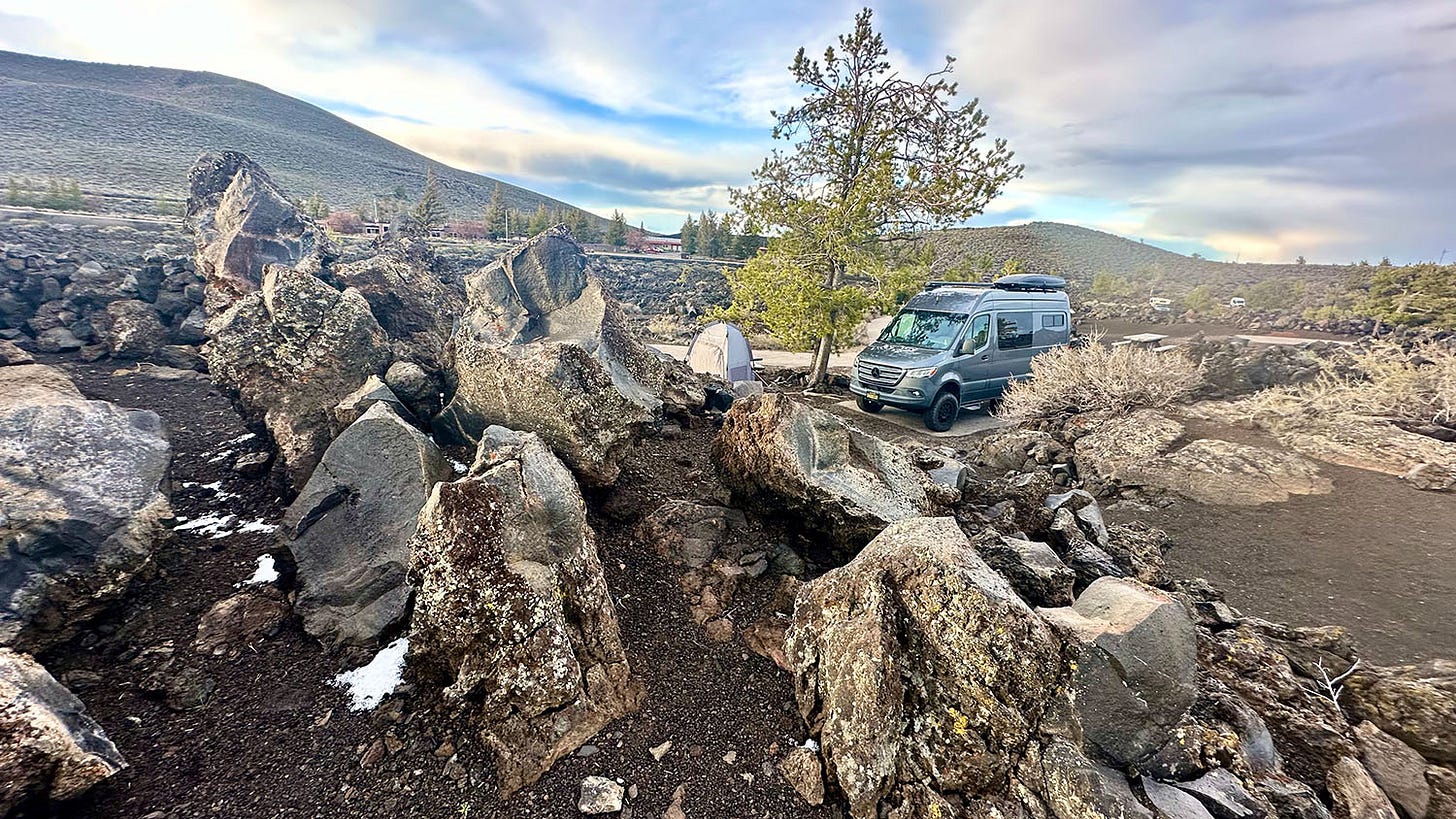
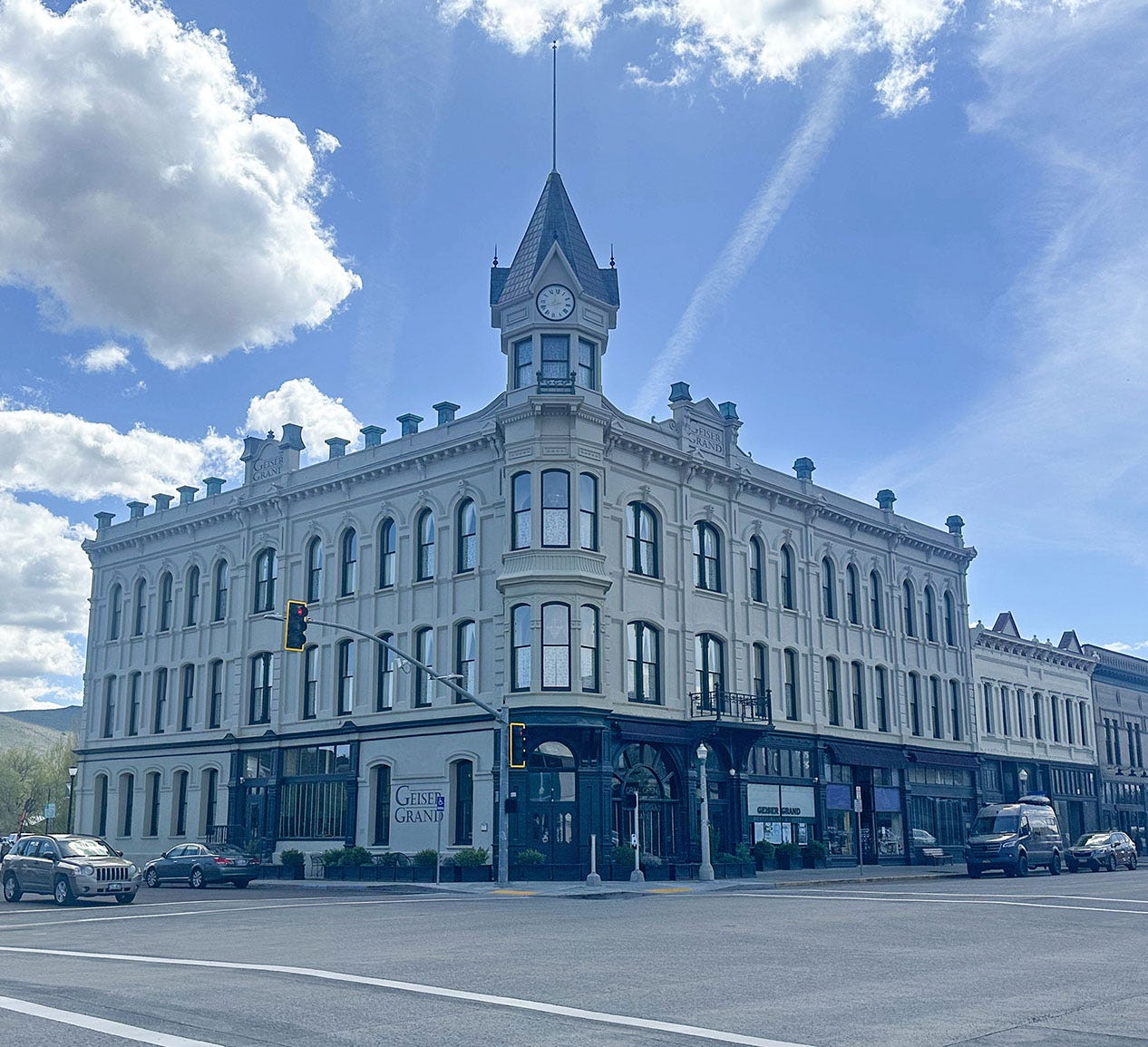
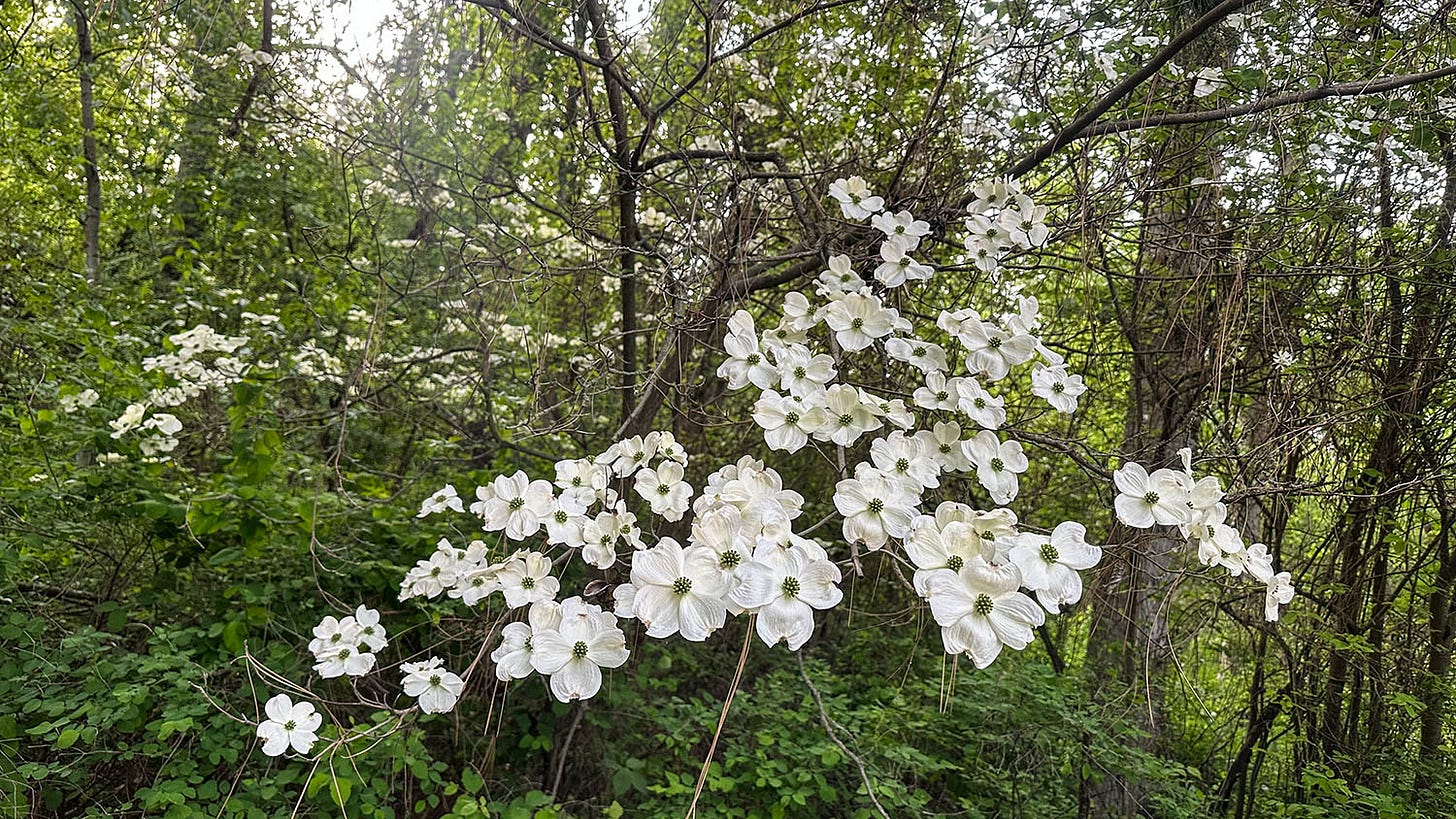
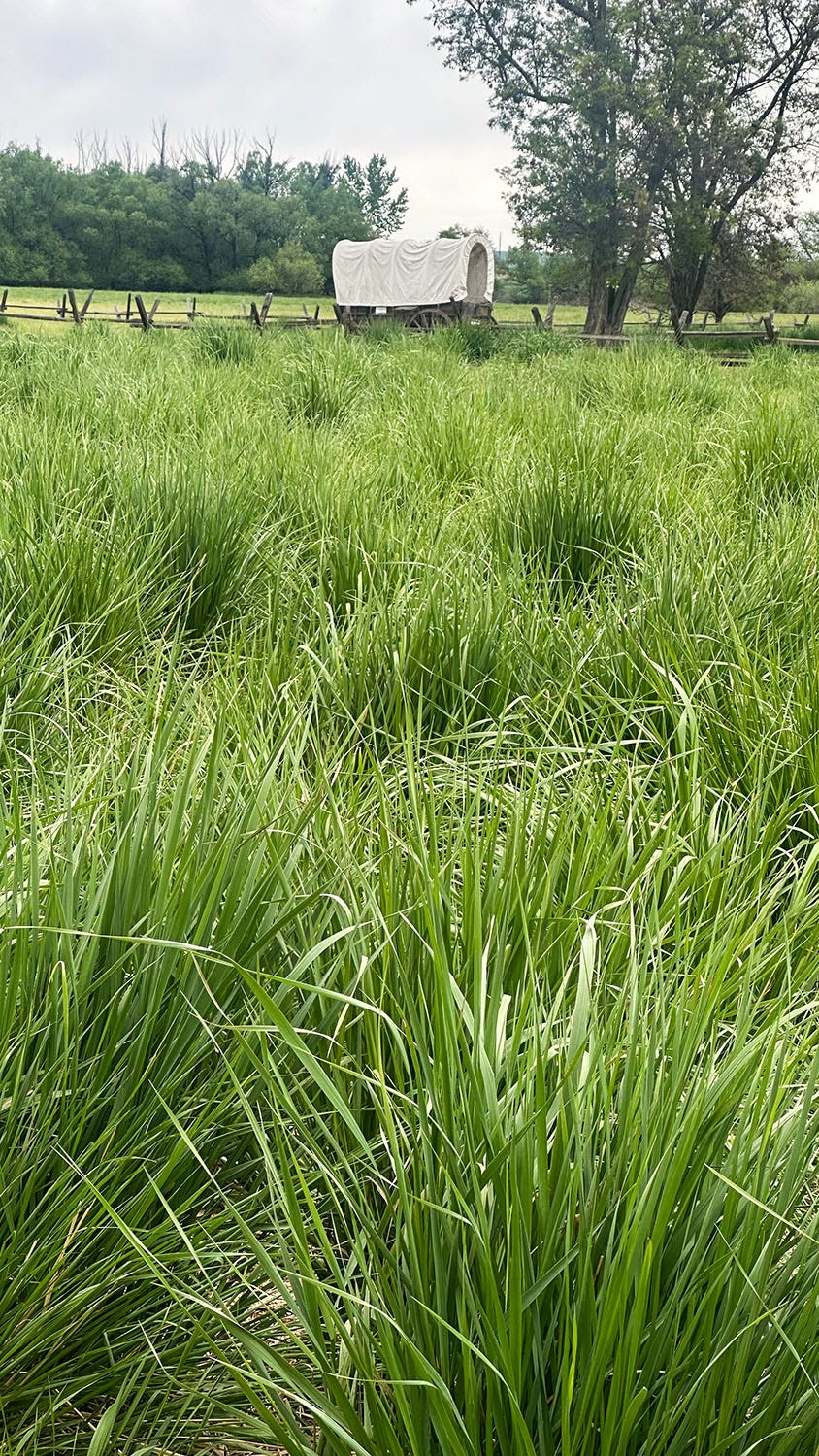


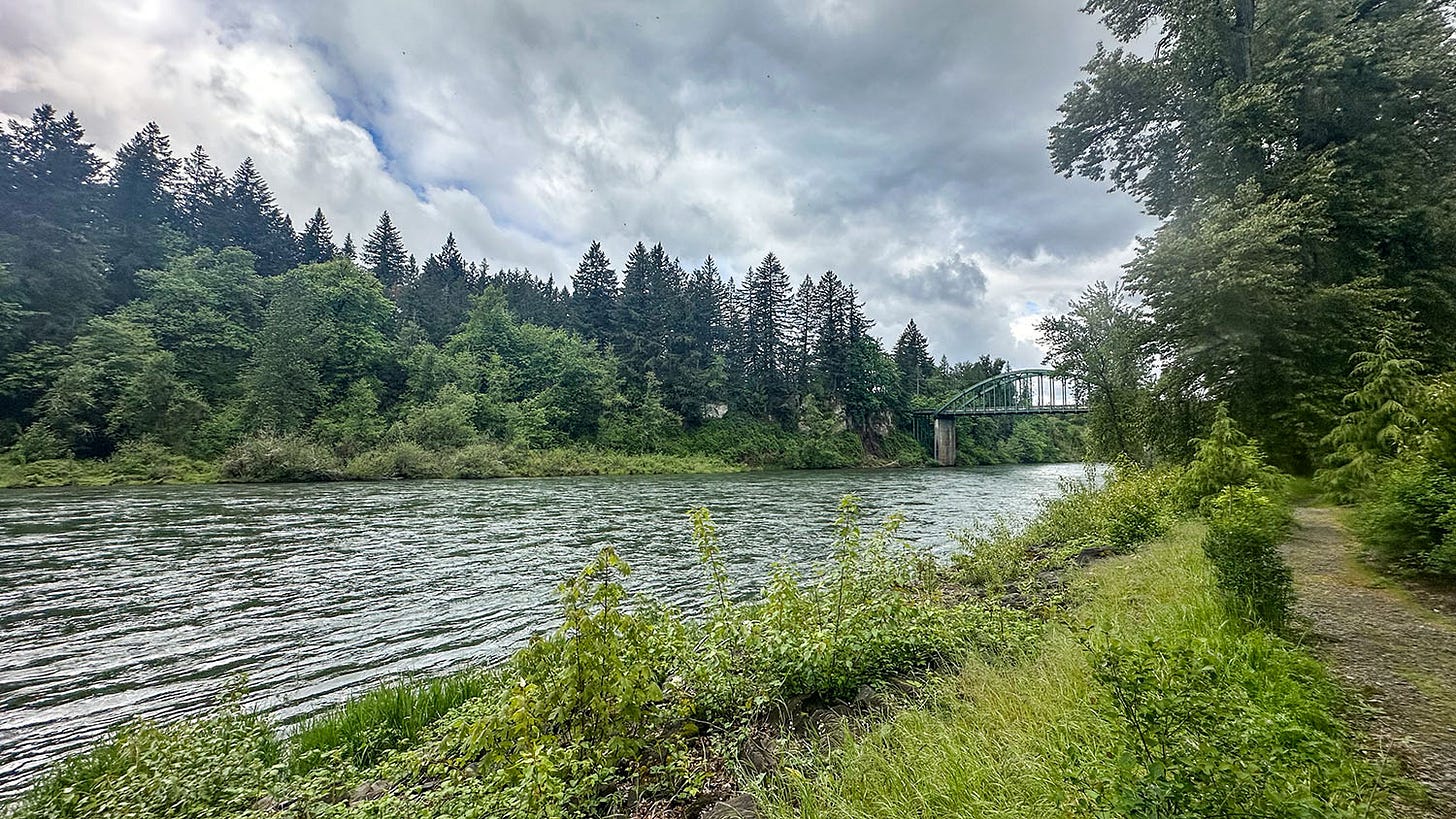
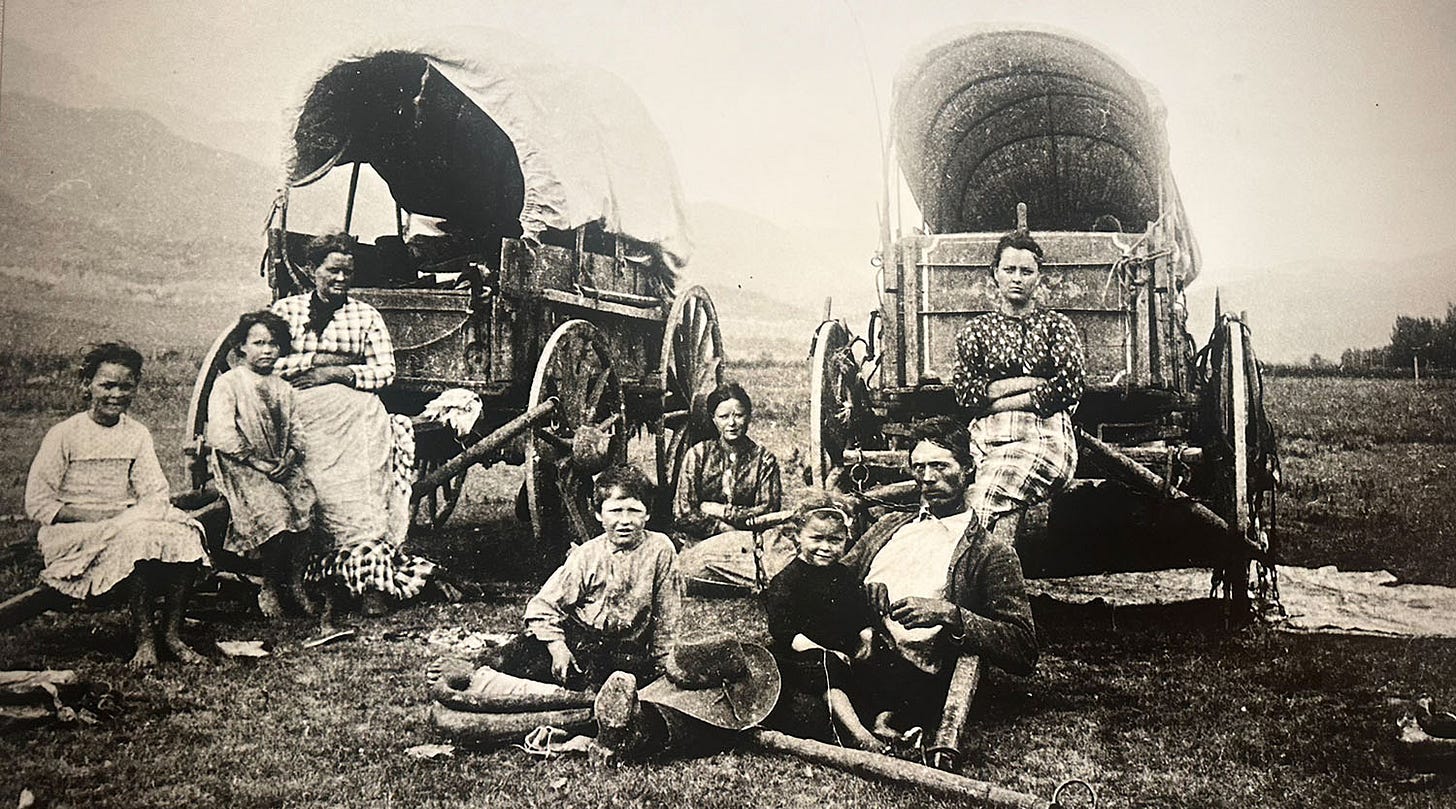
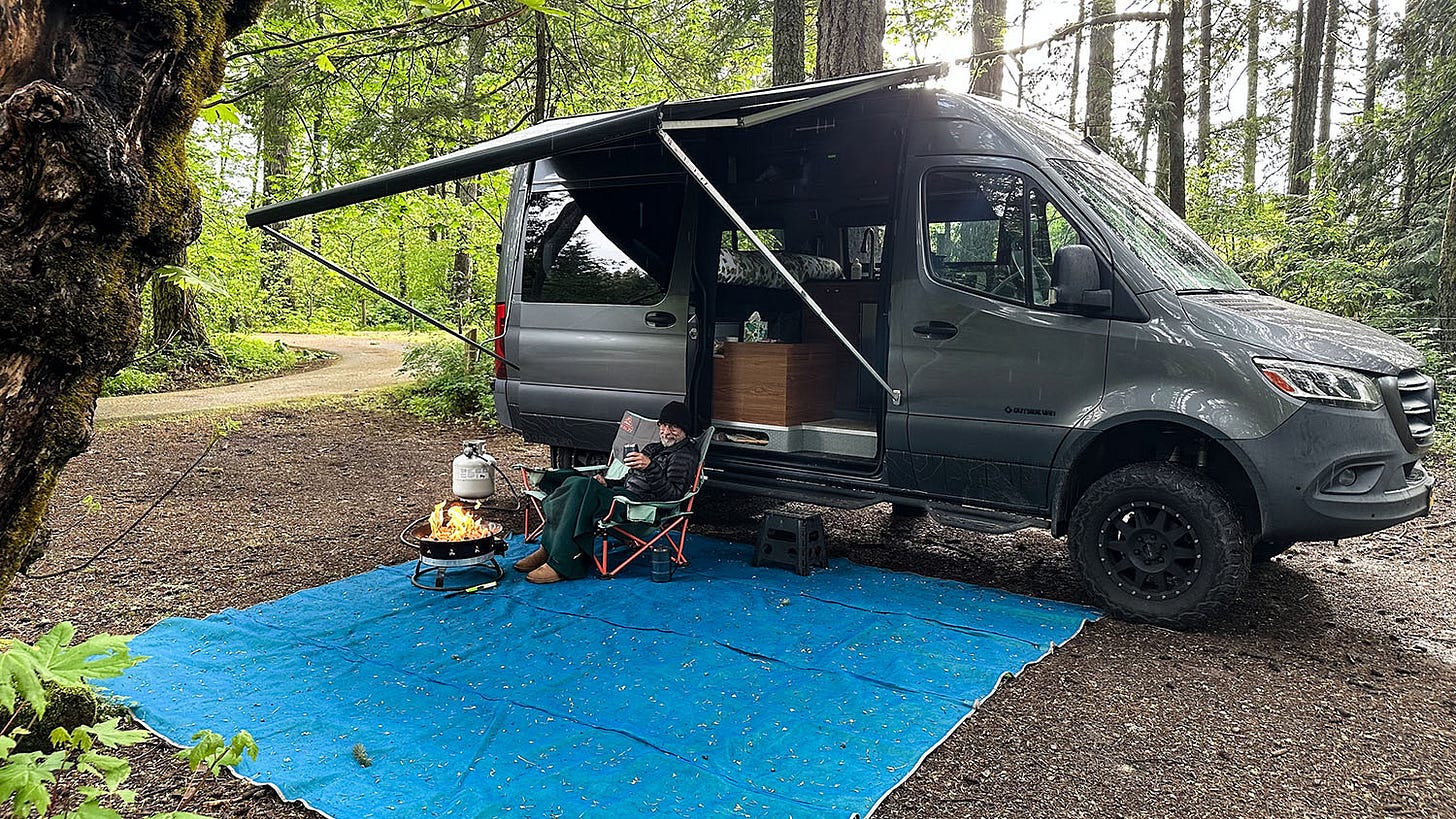
Another wonderful piece, making me wish we could do the kind of traveling you and Les do. It is so sad to think of the missionaries and the US governent sweeping in take away the land and way of life of the native tribes.
Thanks John for another great read.
Really enjoyed a close up look at our history, although saddened by our ancestors arrogance and ignorance.
Thanks for sharing your trip with us, love tagging along .😉